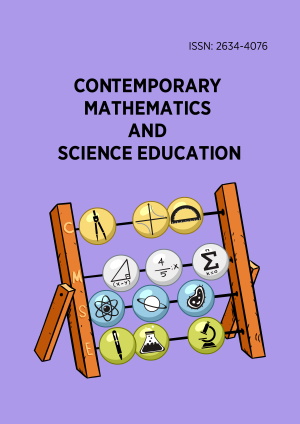Research Article
Virtual School Students’ Reactions to Undertanding Tasks: The Case of Local Extrema Point
More Detail
1 AL-Qasemi Academic- College of Education, Baqa elgarbeia, 30100, ISRAEL2 The Academic Arab College, Haifa. 32623, ISRAEL* Corresponding Author
Contemporary Mathematics and Science Education, 1(2), July 2020, ep20007, https://doi.org/10.30935/conmaths/8496
Submitted: 07 July 2020, Published: 30 August 2020
OPEN ACCESS 1532 Views 1363 Downloads
ABSTRACT
The main aim this study is to examine the understanding of the concept of a local extreme point of differentiable function. Three research questions rose: (a) To what extent do students who study 5 mathematics units in virtual school understand the concept extremum point? (b) To what extent does the concept name (i.e. “extremum point”) influence the mathematical understanding of the concept upon students who study 5 mathematics units in the virtual school? (c) To what extent do students who study 5 mathematics units in the virtual school understand the concept maximum point? To answer the research questions we used qualitative research methods based on semi-structured interviews. The results of the study showed that: All the four interviewers know to find correctly the stationary points, but they don’t distinguish between a stationary point and an Extremum point. All the interviewers mention that the two points are Extremum points instead of stationary points. We have to emphasize that mathematically, a stationary point not necessarily an extremum point. In addition, one of the interviewers confuses an extremum point and a maximum point because of the daily meaning of “Extremum” in Arabic languages. He also reveals Pseudo-Conceptual Behavior; he used sentences like “the tangent equal to 0” instead of the “slope of the tangent equal zero”. It turns out also, that while three out of four interviewers determined the type of the extremum points by using the acceptable value table method correctly, the fourth determines the type of the extremum points by one point and by using the “odd function” characteristic, correctly. According to the requirement to find the extremum point the results showed that two of the four interviewers reveal pseudo-conceptual mode of thinking according to the maximum point concept. They use “slope at the extremum points equal 0”. One of them even used concepts: increasing, decreasing, positive, negative meaninglessly, without clarifying who is positive (negative) or who is increasing (decreasing). One of the important but interesting results is the reaction of the interviewers to the definitions of the maximum point concept. The results showed that 3 students out of 4 gave correct mathematical definition, but; the 4th student gave meaningless definition. We crossed his meaningless answer with his answers to the other questions during the interviews; it turned out that his answers to most of the questions revealed pseudo-conceptual mode of thinking.
CITATION (APA)
Rasslan, S., Shibli, N., & Rasslan-Sharif, A. (2020). Virtual School Students’ Reactions to Undertanding Tasks: The Case of Local Extrema Point. Contemporary Mathematics and Science Education, 1(2), ep20007. https://doi.org/10.30935/conmaths/8496
REFERENCES
- Barbour, M., & Reeves, T., (2009). The Reality of Virtual Schools: A review of the literature. Computers & Education, 52(2), 402-416. https://doi.org/10.1016/j.compedu.2008.09.009
- Fuson, K., & Kown, Y., (1992). Korean Children’s Understanding Multidigit Addition and Substraction. Child development, 63(2), 491-506. https://doi.org/10.2307/1131494
- Miura. I., Okamoto, Y., Vlahovic-Stetic, V., Kim, C., & Han, J. (1999) Language supports for children’s understanding of numerical fractions: cross-national comparison. Journal of Experimental Child Psychology, 74, 356-265. https://doi.org/10.1006/jecp.1999.2519
- Park J. (2012). Students’ Understanding of the Derivative- Literature Review of English and Korean Publications. Journal of the Korean School Mathematics Society, 15(2), 331-348. Retrieved from https://www.koreascience.or.kr/article/JAKO201223052005068.page
- Pinto, M. M. F., & Gray, E. (1995). Difficulties Teaching Mathematical Analysis to Non specialists. Proceedings of PME 19, Recife, Brazil, 11, 18-25.
- Rasslan S., & Mashhari, M., (2019). The Impact of Using Microsoft Math Software on Understanding Mathematical Central Concepts Upon Non-English Speaking Students- the Case Of The “1st Degree Equations” Concept. 5th International Contemporary Educational Research Congress. Theory and Practice in Education. July 25-27, 2019. Frankfurt University of Applied Sciences. Germany.
- Rasslan, S., & Shibli, N., (2020). Students’ Understanding of the Derivative Concept by “The Virtual School”. (to be published).
- Rasslan, S., & Vinner, S. (1998). Images and definitions for the concept of increasing/decreasing function. In A. Oliview & K. Newstead (Eds.), Proceedings of the 22nd conference of the international group for the psychology of mathematics education (Vol. 4, pp. 33-40), Jul 12-17. Stellenbosch: PME
- Rasslan, S., & Vinner. S. (1997). Images and Definitions for the Concept of Even / Odd Function. In Proceeding of the PME 21st 42 Conference of the International Group for the Psychology of Mathematics Education (vol. 4, pp. 41-48). University of Helsinki, Lahti, Finland.
- Schaum’s Outlines, (2020). Calculus, sixth Edition, Chap. 14. NAGWA. https://www.nagwa.com/en/courses/342179296797/
- Skemp, R. R. (1976). Relational Understanding and Instrumental Understanding. Mathematics Teaching, 77, 20-26.
- Tall, D. (1986). Construction the concept image of a tangent. In Proceeding of the eleventh conference of the International Group for the Psychology of Mathematics Education (vol. 3, pp. 69-75), Montreal.
- Tsamir, P., Rasslan, S. & Dreyfus T., (2006). Prospective teachers’ reactions to Right-or-Wrong tasks: The case of derivatives of absolute value functions. The Journal of Mathematical Behavior, 25(3), 240-251. https://doi.org/10.1016/j.jmathb.2006.09.001
- Vinner, S. (1991). Role of definitions in the teaching and learning of mathematics. In D. O. Tall (ed.), Advanced Mathematical Thinking (pp. 65-81). Dordrecht: Kluwer. https://doi.org/10.1007/0-306-47203-1_5
- Vinner, S. (1995). Teaching mathematics as an educational task – teachers’ views about some aspects of their professional lives. Proceedings of the 19th international conference for the psychology of mathematics education. Recife, (III), 328-335. https://files.eric.ed.gov/fulltext/ED411136.pdf
- Zandieh, M. (2000) A theoretical Framework for analyzing students understanding of the concept of derivative. CBMS Issues in Mathematics Education, 8, 103-127. https://doi.org/10.1090/cbmath/008/06

 The articles published in this journal are licensed under the CC-BY Creative Commons Attribution International License.
The articles published in this journal are licensed under the CC-BY Creative Commons Attribution International License.